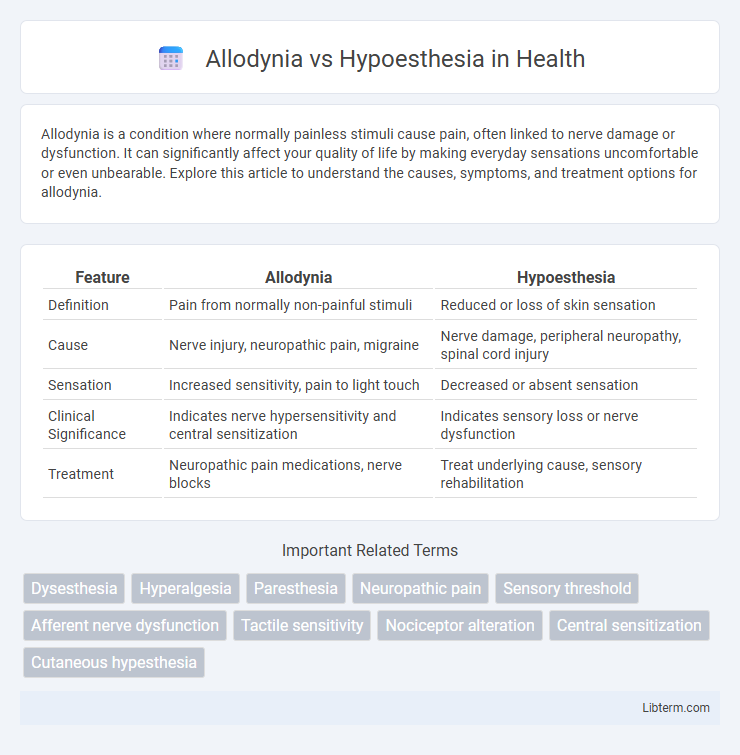Allodynia is a condition where normally painless stimuli cause pain, often linked to nerve damage or dysfunction. It can significantly affect your quality of life by making everyday sensations uncomfortable or even unbearable. Explore this article to understand the causes, symptoms, and treatment options for allodynia.
Table of Comparison
| Feature | Allodynia | Hypoesthesia |
|---|---|---|
| Definition | Pain from normally non-painful stimuli | Reduced or loss of skin sensation |
| Cause | Nerve injury, neuropathic pain, migraine | Nerve damage, peripheral neuropathy, spinal cord injury |
| Sensation | Increased sensitivity, pain to light touch | Decreased or absent sensation |
| Clinical Significance | Indicates nerve hypersensitivity and central sensitization | Indicates sensory loss or nerve dysfunction |
| Treatment | Neuropathic pain medications, nerve blocks | Treat underlying cause, sensory rehabilitation |
Understanding Allodynia: Definition and Causes
Allodynia is a neurological condition where normally non-painful stimuli, such as light touch or temperature changes, trigger pain sensations. It commonly results from nerve damage, neuropathic disorders, or conditions like fibromyalgia and diabetic neuropathy. Understanding the underlying causes of allodynia helps distinguish it from hypoesthesia, which involves diminished sensory perception rather than pain.
What Is Hypoesthesia? Key Features Explained
Hypoesthesia is characterized by a reduced sensitivity to sensory stimuli, often manifesting as numbness or diminished touch sensation. This condition results from nerve damage or dysfunction, affecting the transmission of sensations such as pressure, temperature, or pain. Unlike allodynia, where normal stimuli cause pain, hypoesthesia involves a decreased or absent perception of sensory input.
Comparing Allodynia and Hypoesthesia: Main Differences
Allodynia involves pain from stimuli that usually do not provoke pain, while hypoesthesia is characterized by a reduced sense of touch or sensation. The primary difference lies in the type of sensory alteration: allodynia causes heightened sensitivity and pain, whereas hypoesthesia results in diminished or numb sensation. Both conditions often indicate underlying neurological disorders but require distinct diagnostic and therapeutic approaches.
Common Symptoms of Allodynia
Allodynia presents with pain from stimuli that do not typically provoke pain, such as light touch, temperature changes, or gentle pressure. Common symptoms include burning sensations, aching, or sharp pain triggered by normally non-painful stimuli, often localized to specific body areas. Hypoesthesia, in contrast, involves decreased sensitivity to sensory stimuli, resulting in numbness or reduced tactile perception rather than pain.
Typical Signs and Presentation of Hypoesthesia
Hypoesthesia typically presents as a reduced sense of touch or sensation, often described as numbness or decreased sensitivity in the affected area. Patients may report a diminished ability to feel pain, temperature, or vibration stimuli, usually resulting from nerve damage or neurological disorders. Unlike allodynia, which involves pain from normally non-painful stimuli, hypoesthesia reflects a loss or decrease in sensory perception.
Underlying Mechanisms: How Do Allodynia and Hypoesthesia Occur?
Allodynia occurs due to abnormal neural processing where non-painful stimuli activate pain pathways, often linked to peripheral sensitization and central nervous system changes such as altered dorsal horn neuron excitability. Hypoesthesia results from impaired sensory nerve function, causing reduced sensitivity to tactile stimuli caused by nerve damage, demyelination, or central lesions affecting somatosensory pathways. Both conditions involve disruptions in nociceptive signal transmission but differ fundamentally in their underlying neurophysiological mechanisms.
Diagnosis: How Are Allodynia and Hypoesthesia Identified?
Allodynia is identified through clinical evaluation involving gentle tactile stimuli that normally do not cause pain but evoke discomfort or pain responses, often assessed using light touch or brushing tests. Hypoesthesia is diagnosed by measuring sensory deficits using quantitative sensory testing (QST) or neurological examinations that assess diminished sensitivity to stimuli such as touch, temperature, or proprioception. Both conditions require careful differentiation through patient history and targeted sensory assessments to guide appropriate treatment strategies.
Treatment Options for Allodynia
Treatment options for allodynia primarily include pharmacological approaches such as anticonvulsants (gabapentin, pregabalin), antidepressants (amitriptyline, duloxetine), and topical agents like lidocaine patches. Non-pharmacological therapies like cognitive-behavioral therapy, transcutaneous electrical nerve stimulation (TENS), and physical therapy can complement medication to alleviate symptoms. Unlike hypoesthesia, which often requires addressing underlying nerve damage or systemic conditions, allodynia treatment focuses on modulating pain pathways and reducing nerve hypersensitivity.
Management Approaches for Hypoesthesia
Management approaches for hypoesthesia primarily focus on addressing the underlying cause, such as peripheral neuropathy or nerve compression, through medications like analgesics, corticosteroids, or anticonvulsants. Physical therapy and occupational therapy play essential roles in restoring sensory function and preventing complications, while nerve decompression surgery may be considered in severe cases. Emerging treatments include neuromodulation techniques and regenerative medicine to enhance nerve repair and improve sensory recovery.
When to Seek Medical Attention: Prognosis and Complications
Seek medical attention for allodynia or hypoesthesia when symptoms persist, worsen, or interfere with daily activities, as these conditions may indicate underlying nerve damage or systemic disorders. Early diagnosis and treatment improve prognosis by preventing complications such as chronic pain syndromes, sensory loss, or neuropathic damage. Prompt intervention reduces the risk of permanent nerve impairment and enhances recovery outcomes.
Allodynia Infographic

 libterm.com
libterm.com